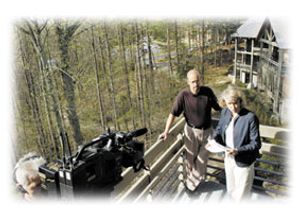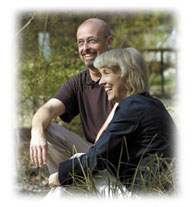
The day couldn’t have been better for filming on the Catawba College campus. The sun was shining. The students were full of excitement about the campus greening initiative. Even the crabapple trees cooperated, offering their fresh pink blossoms as a backdrop for Catawba President Robert Knott’s interview.
;Wanda Urbanska and Frank Levering, co-producers of the PBS show “Simple Living with Wanda Urbanska,” brought their camera crew to campus Wednesday to film footage for a segment on “Simplicity and Environmental Education on Campus.” It will be part of the fifth program in Simple Living’s second run, which will begin airing in October. The series will be available in 77 percent of the TV households across the United States.
Catawba’s segment will focus on what students can learn in the classroom and also what they can do individually and collectively to foster environmental stewardship. “The whole segment is intended to inspire viewers throughout the country to bring better environmental stewardship practices and simplicity education to campus,” Urbanska says.
Urbanska and Levering chose Catawba because “we feel that the Catawba Center for the Environment is a showcase in the state of North Carolina and really nationally for what environmental education can be and should be at the college level,” Urbanska says.
 ;
;
The more they filmed, the more they learned about the center’s influence. “What really impressed us was the confirmation of the center’s outreach both within the campus and in the community as well,” Urbanska says. “The Center for the Environment is a tremendous beacon to the whole region.”
The crew filmed interviews with Center Director John Wear as he stood on the building’s tower overlooking the 189-acre ecological preserve. They also filmed students in one of Wear’s classes as they discussed the relationship between simplicity and conserving resources and how they are trying to accomplish this on the Catawba campus.
“Dr. Wear asked big questions about what is important in the environmental field, and the students were right on top of it,” Levering says. “They are ahead of most of us adults in terms of understanding the problems and connecting the dots between the dire straits we are in environmentally and the urgency of making personal commitments to change our ways and be better environmental stewards.”
The cameraman shot footage of Catawba students as they planted redbud trees and of junior and senior high school students from 12 North Carolina counties who were on campus Wednesday and Thursday for their annual Envirothon competition.
“I think the caliber of environmental education at Catawba is very high,” Urbanska says. “I also think that Catawba fosters a unique sense of empowerment of students and student initiative. The administration seems to nurture student input, as evidenced through the campus greening initiative.”
Environmental science students are spearheading an effort to foster environmentally friendly practices on campus. They are promoting everything from improving energy efficiency and composting food waste to recycling and encouraging green building practices.
Connor Coleman, a senior environmental science major from Cleveland, Ohio, is one of the students who have been instrumental in the campus greening initiative. He stood in front of a newly purchased Earth Tub for composting cafeteria food waste for his interview. “I talked about the story of our campus greening program,” Coleman says.
“I also talked about how the ball really got rolling on composting – how as one student, I was able to research an idea and deliver my findings to Dr. Wear, who approached some trustees and benefactors, and boom, the next thing you know, it was happening.”
Coleman is excited about the prospect of Catawba’s being the focus of one of the Simple Living programs. “It’s a great opportunity,” he says. “I hope a lot of other people – especially college students – get information about what we’re doing so they can apply it to their schools.”
Fred Stanback, Catawba trustee and benefactor, and Susan Kluttz, Salisbury mayor, were also interviewed. Kluttz talked about the center’s impact on the community. “She commented that even if individuals didn’t go to every program the center offers, the awareness, both through the media and word of mouth, was creating a climate of knowledge about the importance of environmental issues throughout the whole community,” Urbanska says.
Wear was pleased with the way the filming went. “I felt inspired listening to the comments of our students and administration and others,” he says. “It made me really proud of what the Center for the Environment has accomplished with the help of this community.”
